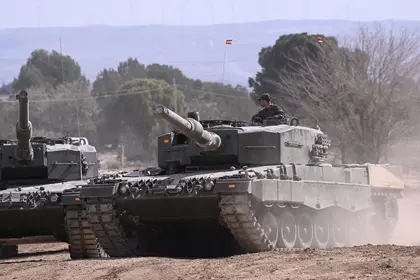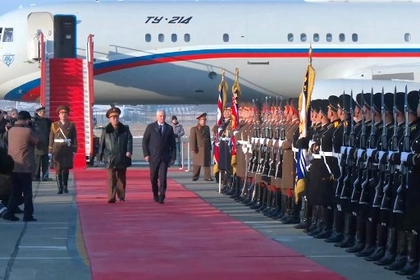Kyiv’s expected spring offensive received a huge boost on Monday evening with the announcement that German and British heavy tanks had finally arrived in Ukraine.
The tanks – long an item on Ukraine’s military equipment wish list – were promised to Kyiv earlier this year and will provide a key infusion of armored firepower that will aid the battle against entrenched Russian troops.
JOIN US ON TELEGRAM
Follow our coverage of the war on the @Kyivpost_official.
How many of the tanks are now in Ukraine?
German Chancellor Olaf Scholz told journalists on Monday that Berlin had provided “very modern” Leopard battle tanks to Kyiv, with the defense ministry later saying 18 were delivered.
“Our tanks have made it into the hands of our Ukrainian friends as promised and on time,” German Defense Minister Boris Pistorius said in a statement.
Shortly after this announcement, the Ukrainian defense ministry revealed they weren’t the only heavy tanks that had been delivered.
Referring to British Challenger 2 tanks, spokeswoman Iryna Zolotar told AFP: “They are in Ukraine already.”
She did not provide any other details, but the U.K. announced in January that it would send 14 of the tanks to the front line.
Has anything else arrived?
Germany’s defense ministry later confirmed the 18 Leopard deliveries, along with two armored “Buffel” tank recovery vehicles. About 40 Marder infantry fighting vehicles have also arrived in Ukraine, he said.

What if Russia Wins?
What has Ukraine said?
Kyiv is obviously very happy with the deliveries. “A year ago, no one would have thought that our partners’ support would be so strong,” Defense Minister Oleksiy Reznikov said on Facebook.
He praised Britain’s Challengers, calling them works of “military art.”
When and where will they be put to use?
The answer to that question depends on whether Ukraine’s army commander Gen. Valeriy Zaluzhny decides to commit heavy tanks to battle in small groups or as part of a major formation, and equally critical is how long he wants to wait before making that decision. If he chooses the small-scale approach, then in most small sectors wherever they are present, the Ukrainian army should be able to stop cold any Russian mechanized assault, or blast any Russian armored vehicles trying to defend a village or a position.
If Zaluzhny were to decide to “go large,” and critically, give his infantry and artillery time to train at operating alongside dozens of heavy tanks, then a ground attack tipped with them would have a real chance of inflicting a major operational defeat on Russian forces. For instance, by pushing 100 kilometers or more to the gates of Mariupol or the Crimean border.
But attempting a large-scale offensive like that without serious combined arms training would be a military risk much higher than the Ukrainian high command has seemed willing to take, ever.
And as for when any tank attack will begin – over the weekend President Zelensky said the much-anticipated spring counteroffensive cannot begin until Western allies send more weapons and ammunition.
In an interview with the Japanese publication Yomiuri Shimbun on March 25, he said he “can’t send our brave soldiers to the front” until the situation is resolved and more “tanks, artillery and HIMARS” have been provided.
Zelensky described the military situation in eastern Ukraine as “not very good” and cited a lack of ammunition as the reason.
Tell me more about the tanks
The Leopard 2 tank is a classic German design and a direct descendent of the famous German Tiger and Panther tanks of World War II. The vehicle is heavily armored, particularly from the front and equipped with top-of-the-line optics and sensors, and a powerful cannon firing ammunition that can destroy any Russian tank at practically any engagement range.
A Leopard 2 tank in the hands of the Armed Forces of Ukraine (AFU) would be most dangerous to Kremlin forces by taking a ridgeline position at long range, in open terrain, where it could pick off Russian vehicles at ranges well beyond which the Russian tank or armored personnel carrier could shoot back accurately, and in most cases before the Russian crew understood it was being targeted. The closer and more restricted the terrain – towns and villages, forests, and swamps – the less a Leopard 2 crew would be able to exploit these advantages.
Now that they’ve been delivered, the Challenger 2 tank has become, overnight, the most advanced tank in the AFU inventory. It is also a giant upgrade over the approximately 350 Soviet-era T-72 tanks Ukraine has received from Poland, the Czech Republic and Macedonia since the full-scale Russian invasion on Feb. 24. First produced in the 1990s and continually updated, the Challenger has operated successfully in the Middle East and Southeast Asia. It is a main battle tank designed to defeat any combat vehicle it comes up against, carrying cutting edge layered armor, modern optics and a 120mm and rifled cannon.
Are Ukrainian crews ready to use them?
Britain’s government said Monday that Ukrainian crews who have been training to use U.K.-donated Challenger 2 tanks are now ready to deploy to the frontline.
“Ukrainian tank crews have completed training on Challenger 2 tanks in the U.K. and have returned home to continue their fight against Russia’s illegal and unprovoked invasion,” the ministry of defense said in a statement.
The training began shortly after London announced in January that it would send 14 of the tanks to the front line. The crews learned how to command, drive and “effectively identify and engage targets,” said the UK ministry, which called it a “step change” in capability for Ukraine’s armed forces.
“It is truly inspiring to witness the determination of Ukrainian soldiers having completed their training on British Challenger 2 tanks on British soil,” said U.K. Defence Secretary Ben Wallace.
How quickly did Ukrainian tank crews master the Challenger 2 tank?
— Ministry of Defence 🇬🇧 (@DefenceHQ) March 27, 2023
🎥 Find out here in our 30 min documentary: https://t.co/eVzqYwrx2J pic.twitter.com/lADZJEThkK
“They return to their homeland better equipped but to no less danger. We will continue to stand by them and do all we can to support Ukraine for as long as it takes,” he added.
Lt. Col. John Stone, who oversaw the training mission, said the British instructors were “hugely impressed with the level of competence displayed” by the Ukrainian crews.
Ukrainian soldiers were also trained on the 2A6s, the most advanced of the Leopard models, on German military bases. They have also trained at Spanish bases.
Has Russia responded to the deliveries?
As Ukraine gains conventional firepower, the Kremlin vowed to follow through on a plan announced by President Vladimir Putin to deploy tactical nuclear weapons in neighboring Belarus, an initiative which has drawn widespread criticism.
Russian President Vladimir Putin said last week that Moscow would be “forced to react” if Britain follows through on a promise to deliver to Ukraine armor-piercing ammunition containing depleted uranium.
What’s Russia’s current tank situation?
Pretty grim. The Dutch military analytical group Oryx has just said that Russia has now lost 1,900 tanks since February of last year.
You can also highlight the text and press Ctrl + Enter






